I lugged my Celestron 8-inch telescope to the dark skies of eastern California on this moonless week. I wanted to see what my my Canon 5D Mark II camera could do with the night sky, far removed from the light pollution of L.A., Vegas, Fresno, and Keeler. I spent the afternoon of December 16 in and around the Eureka Dunes, which are appropriately located in the Eureka Valley. This beautiful area is separated from the Owens Valley on its west side by the Inyo Mountains. The nearest towns are a good 40 to 60 miles distant, so nighttime skies are nice and BLACK! Not counting the stars and planets, of course. There was quite a bit of nuisance cirrus above the Owens and Eureka valleys as the sun set, though. I was a bit perturbed, but most of the cirrus was very thin, and there were some areas of the sky which seemed to be cirrus-free. So, where should I set up? The Eureka Dunes themselves would have been an outstanding location. But, I thought that perhaps the cirrus was decreasing slowly from the west, and if I went farther west, there would be less and less cirrus. The downside to going west was that I would be getting closer to Big Pine and other towns in the Owens Valley. The plus side would be an increase in elevation (and less atmosphere for night sky photography) as I traversed the Inyo Mountains. But the downside to that would be colder temperatures. Fortunately, I had enough on to keep me warm, and winds were very light.
I left the dunes a bit after sunset and headed out of the Eureka Valley and up into the Inyos. The temp was in the 40s in the Eureka Valley (elevation about 3000 feet), but it fell to near freezing fairly quickly as I entered snow-covered terrain above 6000 feet. I decided to stop along a straight and flat stretch of Death Valley Road. I later learned that this was near 7000 feet elevation, not too far east of the road into Saline Valley. Several inches of snow covered the road shoulders. I didn’t want to be walking in snow and freezing my feet faster than necessary, so I parked halfway in the road. I had seen only two other vehicles since early afternoon. As it turned out, no one passed by while I was at this location. The dark and star-filled sky above was fairly spectacular, but there did appear to be some high cirrus around. Oh well, the high clouds weren’t too bad, so I tripodded the 5D and started taking some wide-angle shots of one to two-minutes in length. With wide angle lenses such as 16 mm, you can get away with exposures of about a minute. Exposures of 90 seconds or more start to show the annoying star trails. During the exposures, I set up the C8 telescope and plugged it in to the X-terra’s DC outlet. I was going to try some piggy-back photography while the scope (and its motorized equatorial mount) tracked the sky.
The three images below were tripodded (not tracking). The first one (0919/25mm, 47 sec, f2.8, ISO 800) is looking ENE, towards Auriga and Taurus. The brightest star near the center is Capella. The middle frame (0922/16mm, 76 sec, f3.5, ISO 1000) is looking WNW to NW, towards the “Summer Triangle” stars of Deneb, Altair, and Vega. The Milky Way is nice and bright through Cygnus. Distant high clouds and sky are illuminated, perhaps, by Big Pine and Bishop, and maybe even Mammoth Lakes. The third image (0924/16mm, 68 sec, f3.2, ISO 1000) is looking down the road to the southwest, right at Jupiter. I’m not sure if the light near the horizon on this image (and the previous one) is due to town lights or the last light of dusk. Time of day was about 7:10 p.m. PST.
The seven images below were taken with the camera “piggybacked” on the telescope, so that the night sky would be tracked during the long exposures. I did a really quick and dirty polar alignment, so the tracking is far from perfect, but generally adequate for these wide images. Here are the stats:
0926/16mm, 107 sec, f3.2, ISO 1000
0927/33mm, 101 sec, f2.8, ISO 1000
0930/33mm, 208 sec, f2.8, ISO 800
0931/33mm, 211 sec, f2.8, ISO 800
0932/70mm, 58 sec, f2.8, ISO 800
0933/70mm, 92 sec, f2.8, ISO 1250
0929/33mm, 95 sec, f3.2, ISO 800
0926 is rotated about 45 degrees from level, since the camera is mounted on the scope. This wide angle shot shows much of the telescope tube, since the camera mount is near the back of the tube. In this very wide-angle shot to the east, Orion is about halfway up on the horizon, and the Pleiades star cluster is near the center.
0927 is looking towards Cygnus and its bright star Deneb. Faint nebulosity is visible in the Milky Way, even the North American Nebula, near Deneb and the middle of the image.
0930 is centered near the Pleiades. The purplish California Nebula is visible in the image above the Pleiades. Capella is the bright star in the upper left.
0931 is another view of Orion and vicinity to the east.
0932 is a somewhat tighter view compared to the previous shots, towards the Andromeda/Perseus/Cassiopeia region. This was nearly overhead at the time. The Andromeda Galaxy (M31) is prominent at the bottom.
0933 is a cropped look at part of Orion. The red giant Betelguese shines bright!
0929 is looking nearly overhead again, and you should be able to recognize the “W” outline in Cassiopeia (just above and to the left of center). On the left side of the image is the Double Cluster in Perseus, and M31 appears again near the bottom.
After about 90 minutes of focusing, changing lenses, pushing buttons, wrenching my neck and picture-taking with numb fingers, my extremities had had enough. I packed up the gear and headed back home via Big Pine and the Owens Valley. The thermometer read 22F as I left my lonely location with the heater on high blast. It will be fun to revisit this dark region with the same equipment on a warmer night, without cirrus! I am very impressed with the capabilities of the Canon 5D Mark II beneath starry skies. Of course, Photoshop helped a lot with these images. Exposures were jacked up in each case to bring out more stars. Here are two other versions of image 0933, courtesy of Morganti Magic, Inc.:

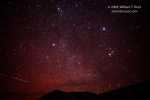
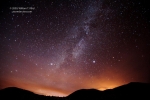

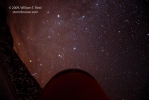
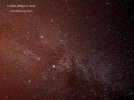
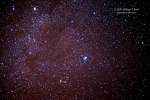
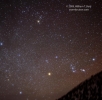
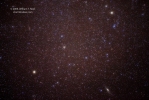
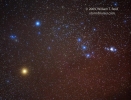
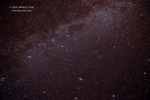
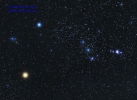
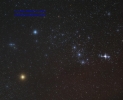
Leave a Reply
You must be logged in to post a comment.